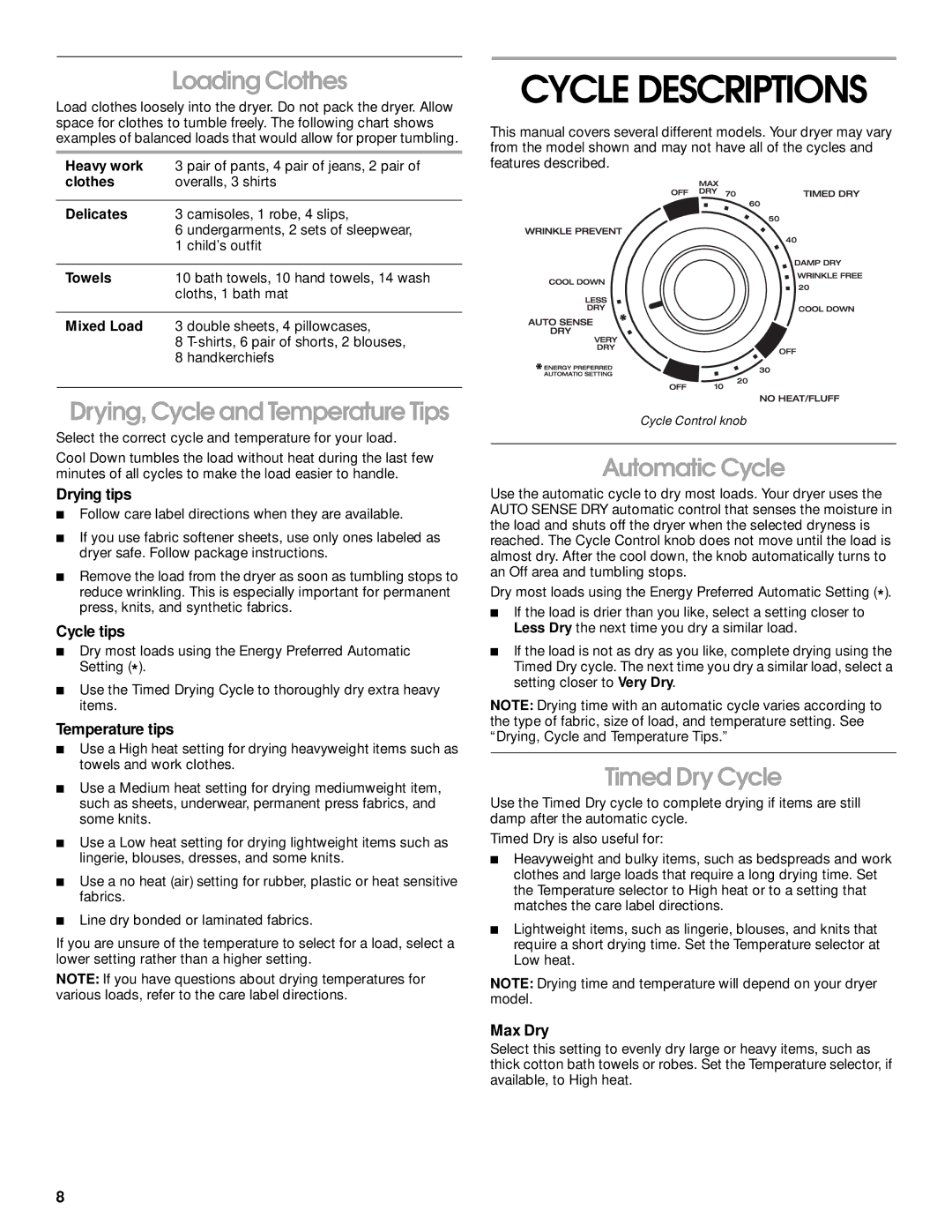
Loading Clothes
Load clothes loosely into the dryer. Do not pack the dryer. Allow space for clothes to tumble freely. The following chart shows examples of balanced loads that would allow for proper tumbling.
Heavy work | 3 pair of pants, 4 pair of jeans, 2 pair of |
clothes | overalls, 3 shirts |
|
|
Delicates | 3 camisoles, 1 robe, 4 slips, |
| 6 undergarments, 2 sets of sleepwear, |
| 1 child’s outfit |
|
|
Towels | 10 bath towels, 10 hand towels, 14 wash |
| cloths, 1 bath mat |
|
|
Mixed Load | 3 double sheets, 4 pillowcases, |
| 8 |
| 8 handkerchiefs |
CYCLE DESCRIPTIONS
This manual covers several different models. Your dryer may vary from the model shown and may not have all of the cycles and features described.
Drying, Cycle and Temperature Tips
Select the correct cycle and temperature for your load.
Cool Down tumbles the load without heat during the last few minutes of all cycles to make the load easier to handle.
Drying tips
■Follow care label directions when they are available.
■If you use fabric softener sheets, use only ones labeled as dryer safe. Follow package instructions.
■Remove the load from the dryer as soon as tumbling stops to reduce wrinkling. This is especially important for permanent press, knits, and synthetic fabrics.
Cycle tips
■Dry most loads using the Energy Preferred Automatic Setting (*).
■Use the Timed Drying Cycle to thoroughly dry extra heavy items.
Temperature tips
■Use a High heat setting for drying heavyweight items such as towels and work clothes.
■Use a Medium heat setting for drying mediumweight item, such as sheets, underwear, permanent press fabrics, and some knits.
■Use a Low heat setting for drying lightweight items such as lingerie, blouses, dresses, and some knits.
■Use a no heat (air) setting for rubber, plastic or heat sensitive fabrics.
■Line dry bonded or laminated fabrics.
If you are unsure of the temperature to select for a load, select a lower setting rather than a higher setting.
NOTE: If you have questions about drying temperatures for various loads, refer to the care label directions.
Cycle Control knob
Automatic Cycle
Use the automatic cycle to dry most loads. Your dryer uses the AUTO SENSE DRY automatic control that senses the moisture in the load and shuts off the dryer when the selected dryness is reached. The Cycle Control knob does not move until the load is almost dry. After the cool down, the knob automatically turns to an Off area and tumbling stops.
Dry most loads using the Energy Preferred Automatic Setting (*).
■If the load is drier than you like, select a setting closer to Less Dry the next time you dry a similar load.
■If the load is not as dry as you like, complete drying using the Timed Dry cycle. The next time you dry a similar load, select a setting closer to Very Dry.
NOTE: Drying time with an automatic cycle varies according to the type of fabric, size of load, and temperature setting. See “Drying, Cycle and Temperature Tips.”
Timed Dry Cycle
Use the Timed Dry cycle to complete drying if items are still damp after the automatic cycle.
Timed Dry is also useful for:
■Heavyweight and bulky items, such as bedspreads and work clothes and large loads that require a long drying time. Set the Temperature selector to High heat or to a setting that matches the care label directions.
■Lightweight items, such as lingerie, blouses, and knits that require a short drying time. Set the Temperature selector at Low heat.
NOTE: Drying time and temperature will depend on your dryer model.
Max Dry
Select this setting to evenly dry large or heavy items, such as thick cotton bath towels or robes. Set the Temperature selector, if available, to High heat.
8
